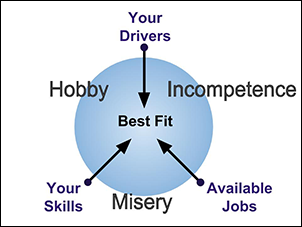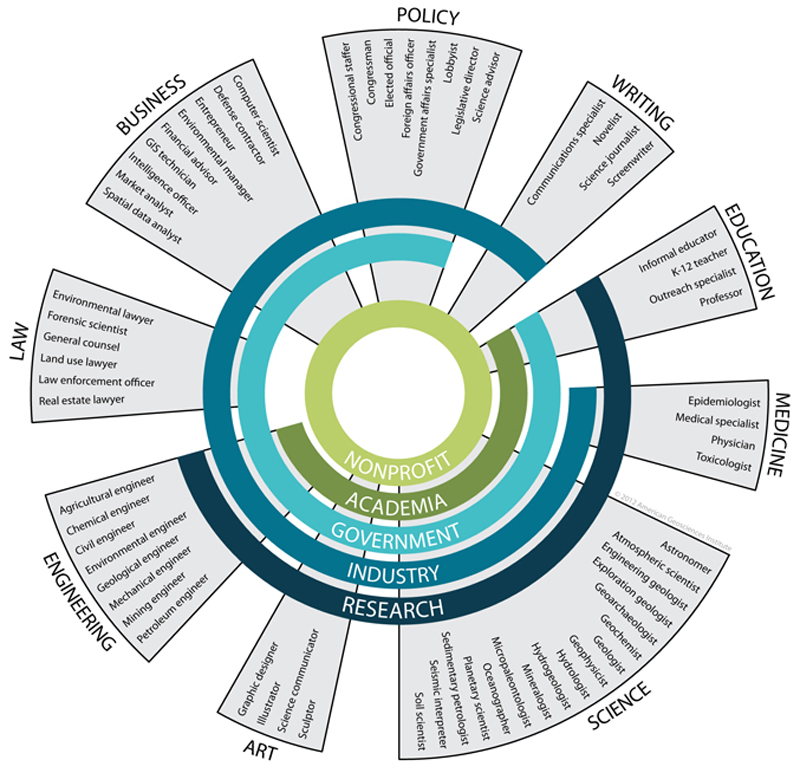Just as there are many kinds of outfits, there are many career options, but they won’t all fit you equally well. To find your ideal fit, cut from the same cloth as a personal stylist.
First, you’ll need to work with what you’ve got—what are your skills? Next, find your style—what factors drive you? Finally, take stock of what’s in store—what jobs are available? You’ll find your best fit where these three factors meet.

You should avoid areas where only two of the three factors for fit align. For example, when you find something that maps well with your passions and skills but no one will pay you to do it, that’s a hobby. When someone wants to pay you for a job that matches your skills but not your drivers, that’s misery. And when you find a job that matches your drivers and pay requirements but not your skills, you’re likely to be incompetent at it. You can exist in a job where only two vectors align for short periods, but it is unlikely that you will perform well or be motivated enough to advance.
But when all three align: Magnifique! Below is a four-step exercise to help you find your best career fit.
1. Evaluate Your Technical Skills
This seems easy. After all, one would hope that you know what you’re good at. However, there are some nuances to explore here.
To find your ideal fit, cut from the same cloth as a personal stylist.
The exact makeup of the skills required will depend on the specific job and industry. Specific skills for a given job will be embedded in the job listing, either explicitly or implicitly.
Skills can be broken down into two categories: technical and nontechnical. Even though this exercise is about finding your fit, any time you’re looking for work, you have to meet on the employers’ terms. For that reason, we’re going to explore skills by looking at a sample text from a job posting.
REQUIRED QUALIFICATIONS
- M.S. with a focus on remote sensing, hydrology, agriculture, atmospheric science, or a related field from an accredited institution
- Experience with GIS and remote sensing of evapotranspiration
- Demonstrated experience in spatial analysis and modeling software platforms such as ArcGIS
Competency in baseline technical skills is implied from your degree. Instead of providing a full list of skill requirements, employers will specify the level and area for the degree required. Technical skills outside of the standard curriculum will be listed separately, like the second and third bullet points in the example listing. No surprises here: either you can do these things or you can’t.
2. Catalog Your Nontechnical Skills
To be successful in any workplace, you will need to be more than just a good scientist. You will also need nontechnical workplace skills like communications (oral and written), professionalism, integrity, and project management.
Although the exact composition of nontechnical skills needed for any given employer or job description may differ slightly, here is a list of nontechnical skills valued most often by employers:
- Effective communications (oral and written): imparting or exchanging of information or news with team members, supervisors, and customers
- Adaptability: successfully responding to changes in workplace priorities and structures
- Systems thinking: understanding why you are working on a particular project and its importance to the organization
- Proactive nature: anticipating problems and solving them before detrimental effects are apparent
- Professionalism: displaying the behaviors, attitudes, and characteristics consistent with a profession
- Persistence: the ability to overcome obstacles and adversity to achieve the desired outcome
- Cultural and social awareness: awareness of the value of diversity and inclusion in the workplace, as well as a respect for the customs and practices of different cultures
- Teamwork: the ability to get along and work with others to accomplish a common goal
- Ethical practices: doing the right thing and doing it right
- Time, project, and financial management: the ability to effectively schedule and utilize resources in the accomplishment of a goal
Nontechnical workplace skills are sometimes labeled as soft skills. The word “soft” might imply that they are somehow less important than “hard” skills like science, but don’t be misled: These skills are certainly a requirement for success. Rather than think of these skills as soft, you should consider them to be essential.
Look at the following list of sample qualifications taken from another job description.
- Excellent oral and written communication skills
- Evidence of the ability to participate in collaborative research
- Ability to participate in the development of research proposals
- Ability to work independently to fulfill project goals and meet project deadlines
Although technical skills often seem self-explanatory, nontechnical skills require some imagination. These nontechnical skills are often gained through experience, as opposed to formal training.
You may be hired on the basis of your technical skills, but if you get fired, it will likely be caused by the nontechnical skills that you lack.
Now freeze: When you looked at the list of qualifications above, did you quickly skim through them or think about ways that you have demonstrated those skills in the past? Don’t fall into the trap of writing off nontechnical skills. You may be hired on the basis of your technical skills, but if you get fired, it will likely be caused by the nontechnical skills that you lack.
As an exercise, consider each of the required qualifications and list a handful of projects where you used that skill. No, seriously—look at the job requirements above and write some things down. Then hold on to your lists! You’ll need concrete examples of your nontechnical skills for your resume, cover letter, and interviews.
3. Figure Out What Drives You
Having a firm grasp of your skill set is important, but skills are only the first step in successfully landing a well-fitting job. As mentioned earlier, it is possible to find a job where you match the skill requirements and still be miserable. You will need to identify skills that you are both able and willing to consistently execute. You need to identify the activities and outcomes that will drive you toward successfully completing tasks.
The things that we value in life collectively drive our behaviors. Simply put, your drivers are what reward and stimulate you. Drivers vary from person to person, but there are a few that we find common to the workplace.
- Advancement: opportunity for promotion or recognition
- Altruism: opportunity to contribute to the welfare of others
- Autonomy: freedom and ability to be self-directed
- Balance: ability to prioritize personal and business matters
- Challenge: drive to overcome obstacles and solve problems
- Discovery: developing understanding for its own sake
- Money: abundant financial compensation
- Structure: clear organizational goals and responsibilities, no ambiguity
- Perfectionism: doing things exactly right, no matter how long it takes
- Security: stability and predictability
Although all the drivers above are important, some will be more important to you than others at this stage of your career. Look at the list and rank your drivers from 1 to 10, with 1 being what you currently value most and 10 being the least.
Your order of these drivers will change over your lifetime. For example, younger people who have few financial commitments might not rank security as highly as midcareer people who have greater financial responsibilities, like a mortgage or hungry children. For this reason, it is important to revisit the ranking of your personal drivers each time you go through a life transition.
Search your soul. Self-reflect. Ask yourself what you truly want.
Now that you’ve taken time to assess your drivers, revisit that list of skills you compiled. How do those skills match up with your driver rankings? Is there any clear alignment?
4. Search Available Jobs
Finding available jobs is easy. Our goal here is not just to find a job, however; it is to find a job where you will thrive.
In the diagram above you were warned against finding yourself in the hobby zone, when something maps well with your passions and skills but nobody will pay you to do it. The obvious remedy? Find someone who will.

This infographic from the American Geosciences Institute (AGI) shows the many occupations that can be found in the Earth and space sciences. Each spoke represents a particular field that includes geoscience professionals; the inner circles demonstrate the employment sectors where particular geoscience professions can be found. As you can see, several fields bridge across employment sectors. For example, you can be a soil scientist in industry, academia, the government, or a nonprofit. You could even be an independent consultant who specializes in soil science and work for yourself.
More information about each job, including job descriptions and profiles of Earth and space scientists, can be found on the AGU Career Center website in the Paths Through Science section.
We can become so focused on our specialties that we forget that our core competencies often overlap across many disciplines.
After browsing through the possible routes a career in the geosciences can take in the infographic above, think about which jobs mesh well with your skills and drivers. Look on a job board, and see if you can find anything available in that occupation. If there are no current openings for a particular profession, are there listings for similar occupations in the same field? Sometimes in the sciences, we can become so focused on our specialties that we forget that our core competencies often overlap across many disciplines. If nothing is available now, look for positions that will make it simpler to get there when something does become available.
The Dream: A Job That Fits You Right
In the end, the career that you pursue is your choice. The better you know yourself and your options, the better your chances of finding the career path that fits you best are.
Last, don’t be discouraged if it takes a while to find your exact path. Finding your fit isn’t always a simple process. Even tailor-made pants have to be broken in at first!
For more career advice or to see listings of jobs available in the Earth and space sciences, visit the AGU Career Center.
Author Information
David Harwell, Assistant Director, Talent Pool, AGU; and Nathaniel Janick (email: [email protected]), Career Services Coordinator, AGU
Citation:
Harwell, D.,Janick, N. (2017), Four steps to finding your career fit, Eos, 98, https://doi.org/10.1029/2017EO069091. Published on 06 March 2017.
Text © 2017. The authors. CC BY-NC-ND 3.0
Except where otherwise noted, images are subject to copyright. Any reuse without express permission from the copyright owner is prohibited.

